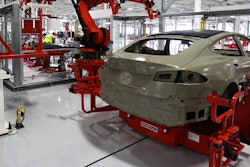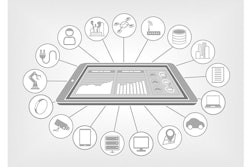
Epicor
Produced by: Sponsored by:
Strategies to Drive and
Sustain Business Growth
Using the Cloud
i-Report
Introduction: Sustaining Your Competitive Advantage
In today’s ever-evolving marketplace, manufacturers across the industry feel the pressure to
remain competitive. Spurred by automation, globalization, new manufacturing techniques and
shifting customer demands, manufacturers are keen to integrate new strategies to achieve
renewed operational growth and improved efficiency.
But, as manufacturing veterans and industry experts will attest, the real trial lies in not just
driving growth — but in being able to sustain it.
“Manufacturing in America today is a very different technological game than it was just 10
years ago — regardless of how high or low tech your output is,” says Craig Downing, the Senior
Director of Global Cloud Marketing at Epicor. “But the good news is that, as a manufacturing
community, we’ve pulled ourselves out of the economic malaise that we had to endure over the
last decade. Most manufacturers today are in a much stronger, sustainable position.”
According to a 2015 study1 from the Aberdeen Group that focused on business growth and
Enterprise Resource Planning (ERP) solutions, the number one challenge facing manufacturers
today is “managing business growth.” And, while growth is an objective necessity of any
business, the added complexities that result from it must also be supported with effective
strategies and solutions.
“A shift in the balance of customer knowledge and skills, along with higher expectations of
quality, service, delivery and price have baked into the modern manufacturing landscape,”
affirms Downing.
“This makes for a very different playbook than the one we used in 2006, but modern
manufacturers understand that they need technology to respond to these changes.”
This report will outline the advantages of adopting cloud-based applications and software to
manage new business growth, with a specific focus on the challenges of and strategies for
sustaining an efficient enterprise.
The NUMBER ONE
challenge facing manufacturers
today is “managing
business growth.”
Strategies to Drive and Sustain Business Growth Using the Cloud 2
3Looking to the Cloud
With business growth – either planned or unplanned — comes a host of challenges that
manufacturers must learn to navigate to enable future growth. Nowadays, a growing number
of manufacturers are utilizing the Cloud and cloud-based applications to do just that.
In the study referenced above, the Aberdeen Group2 found that an incredible “97 percent of
leading manufacturers are utilizing ERP solutions to manage their business.”
Why such a high rate of adoption?
According to Aberdeen Group researchers3 , “As organizations grow, they are faced with more
complex operations and decisions, are exposed to more competitors, and incur increased costs.
In cases such as these, manufacturers rely on technology and ac-
cess to accurate data to do much of the heavy lifting.”
“Despite being a technologist, I’m never going to advocate
for technology for the sake of technology,” Downing explains.
“But I think the question that everyone should be asking is: ‘Look-
ing at our key business workflows, can we use modern technology to make them better, faster,
cheaper and more efficient?’”
In short, keeping costs under control, maintaining a smooth operation, meeting customer
service demands and appearing organized in general becomes a juggling act. Communication
and collaboration challenges also become compounded with expanded growth.
So, while necessity is perhaps the biggest driver of changes on the plant floor, there are
significant advantages to companies who choose to implement cloud solutions.
Mitigating Risks & Improved Security
“Companies have traditionally struggled to access and manage data across multiple
departments,” acknowledges4 Corcentric COO Matt Clark.
And, as companies grow, so does the likelihood of becoming susceptible to a seemingly infinite
number of risks — something manufacturers consistently cite as a top concern.
In fact, according to a 2016 report from5 TEKSystems, “Companies feel more secure about their
ability to define and plan IoT (Internet of Things) initiatives than they do about actually putting
information security or Big Data practices in place.”
An incredible 97% of leading manufacturers are
utilizing ERP solutions to manage their business.
Strategies to Drive and Sustain Business Growth Using the Cloud
4Strategies to Drive and Sustain Business Growth Using the Cloud
Additionally, according to “A Manufacturer’s
Guide to Growing Profitability6” released
by Epicor, 53 percent of more than 1,000
manufacturers surveyed agreed that “business
growth may put excessive pressure on opera-
tions, damaging quality and customer satisfac-
tion.” Fifty percent of the same respondents also
agreed that “unplanned business growth may
lead to unexpected consequences which would
have a negative impact on the business.”
But Clark says that companies who embrace
cloud-based solutions will not only see
operational improvement but also gain
insight to prevent future risks.
“Utilizing the Cloud gives companies on-demand
access to a shared system of data and resources,
making this process a more tangible and efficient
undertaking,” Clark says. “Implementing a system
of risk prioritization will not only help in manag-
ing and resolving issues more effectively, but it
will ensure that each team member involved is on
the same page when it comes to where time and
effort should be spent — from project manager to
CEO and everyone in between.”
Downing agrees.
“The Cloud is simply the leading edge of this technology,” he confirms. “Most companies don’t
write [or buy] legacy deployed software today, so it’s unlikely you’re going to find the ‘best of
the best’ capabilities to do routine things in old ERP systems. Plus, there are certain things that
you can only do because of the Cloud and the Internet.”
Profit Margins
According to Epicor’s survey7 of around 1,000 manufacturers, 82 percent “agreed that an
effective and integrated IT infrastructure is essential for business performance,” while 40
percent named “having the right technology in place” as a proven success factor in any
manufacturing organization.
But, of course, a return on investment (ROI) is also critical when financing this technology to
make your plant run more efficiently.
A 2015 Small Business Cloud Barometer8, found that “revenue growth increased by 25 percent
and profits more than doubled compared to businesses that did not use the Cloud.” This same
82% of
manufacturers agreed
that an effective
and integrated IT
infrastructure is
essential for business
performance.
report also found that more than half of U.S. businesses participating in the survey used some
form of cloud software and that nearly 30 percent used three or more cloud applications.
“The benefits [of the Cloud] are overwhelming,” says Downing. “It’s cheaper. It’s more secure.
You don’t have your IT staff working on low-value activities like running backups. Upgrades
happen automatically. I think we’ve transcended the curve to the point where people wouldn’t
think of ever buying an on-premises CRM system. And we’re pretty much there with ERP.”
Using the Cloud as a tool to help sustain and improve upon your company’s business growth is
an invaluable strategy toward long-term growth. Moreover, and as the data above suggests, an
investment in streamlining the operational efficiency of your enterprise is essential — especially
to remain competitive and flexible in an already-competitive marketplace.
• Evaluate what challenges you perceive to sustained
business growth and becoming a more seamless
operation. Define what you need and what you’d
like to have by gathering the subject matter experts
you have on-site and talking to plant supervisors
and managers. An outside vendor could also prove
useful in this audit of your current operational
efficiency.
• Identify and consider analytics to maximize your
operation’s full potential. Make informed, data-driv-
en decisions to create a clearer, more focused path
toward sustained business growth.
• Consider how your competitors are tackling growth
and what you might be able to learn from what
they’ve done.
• Commit to collaborating with your staff and man-
agers about what solutions might work best within
your specific company culture, especially in regards
to training. Discuss the potential challenges and
benefits to find an ERP system that best aligns with
your long-term goals and ambitions. Be realistic in
your expectations and grounded in your reasoning.
While keeping in mind the importance of a contextualized solution,
here are some recommendations to help best define what cloud
solutions might work best within your enterprise.
5Strategies to Drive and Sustain Business Growth Using the Cloud
Building Growth Strategies
In its survey of more than 1,000 manufacturers9, Epicor asked respondents to reveal “key
success factors and risks of growth for manufacturers.”
A whopping 60 percent answered that “good planning” was the largest factor along their
company’s path to growth.
Staying ahead of the curve by establishing key strategies to handle your business growth will not
only improve productivity but also give manufacturers added flexibility and a competitive edge.
However, another important point manufacturers should consider is “which cloud” is right for
their enterprise.
“There are multiple ways to benefit from the Cloud,” explains Downing. “Some clients simply
take their existing on-premises licensed system and deploy it on an Infrastructure-As-A-Service
(IaaS) provider like Amazon or Azure. Other clients want a bit more support and elect to have
their system run as a managed service. And then, there are options with most modern ERP sys-
tems to deploy them as Single Tenant or Multi-Tenant systems. There are certainly cases for each,
as well as technical and business benefits of each. That’s why we say there is no ‘right’ answer
for any client, and stress the importance of having choice in which cloud deployment model is
best for each client.”
Another important point manufacturers
should consider is questioning
“which cloud” is right for them.
Strategies to Drive and Sustain Business Growth Using the Cloud 6
7Strategies to Drive and Sustain Business Growth Using the Cloud
Summary
To some, business growth can be perceived as both a blessing and a curse — and perhaps
rightfully so.
The challenges inherent in adapting to and evolving with your growing business are many, but
the Cloud can help.
When asked if it was too late for manufacturers who haven’t yet made the switch to the Cloud,
Downing quickly replied in the negative.
“Oh no, of course not. It’s a lot like saving for retirement in that it’s never too late. But the sooner
you start the better off you’ll be financially. An overwhelming number of studies have proven
the ROI and the TCO of the Cloud to be so overwhelmingly positive that it’s widely accepted that
continuing to run on-premise will actually hurt your economic return.”
In closing, consider again the many advantages of evolving your growth strategies, including
real-time collaboration and data connectivity, superior organizational efficiency, and improved
security and risk mitigation. Also, consider the need to remain competitive in a global market-
place that’s continuing to evolve alongside shifts in customer demands.
Ultimately, the decision to rely on technology and cloud-based platforms can dramatically impact
how fast — and how profitably — a manufacturing enterprise can drive and sustain its business
growth.
To learn more about how cloud-based applications can drive your company’s business growth,
visit Epicor.com.
1. Grow Your Manufacturing Operations By Selecting Easy-To-Use. (November 2015)
2. Ibid.
3. Ibid.
4. Matt Clark, “Three Benefits of Adopting Cloud-Based Solutions,” http://ow.ly/eoo5305YPUv (March 2016)
5. Megan Crouse, “Companies Aren’t Quite Ready For The Internet Of Things,” http://ow.ly/eoo5305YPUv (February 2016)
6. “A Manufacturer’s Guide to Profitability,” Epicor (March 2016)
7. Ibid.
8. Andy Szal, “Report: Cloud Use Corresponds With Higher Revenues, Profits” http://ow.ly/iwnJ305Z35e (August 2015)
9. “A Manufacturer’s Guide to Profitability,” Epicor (March 2016)
8Strategies to Drive and Sustain Business Growth Using the Cloud
About This Report
The information in this report was researched and produced by Manufacturing.net in
conjunction with Epicor. Statistical data was researched and compiled by Advantage
Business Media in November 2016.
About Epicor
Epicor provides flexible, industry-specific software designed around the needs of our
manufacturing, distribution, retail and service industry customers. More than 40 years of
experience with unique business processes and operational requirements are built into every
solution in the Cloud or on premises. With this deep understanding, Epicor solutions manage
complexity, increase efficiency, and free up resources so you can focus on growth. For more
information, connect with Epicor or visit epicor.com.
About Advantage Business Media
Advantage Business Media is a data-driven marketing solutions company leveraging content,
technology, and business intelligence to match its audience’s job performance needs with its
clients’ solutions. With a diversified portfolio of highly focused websites, e-newsletters, print
publications, specialized directories, vertical search databases, conferences, ancillary media
vehicles, and associated web-based services, ABM serves more than one million industry
professionals in the manufacturing, science, and design engineering markets. For more
information visit www.advantagemedia.com.






















